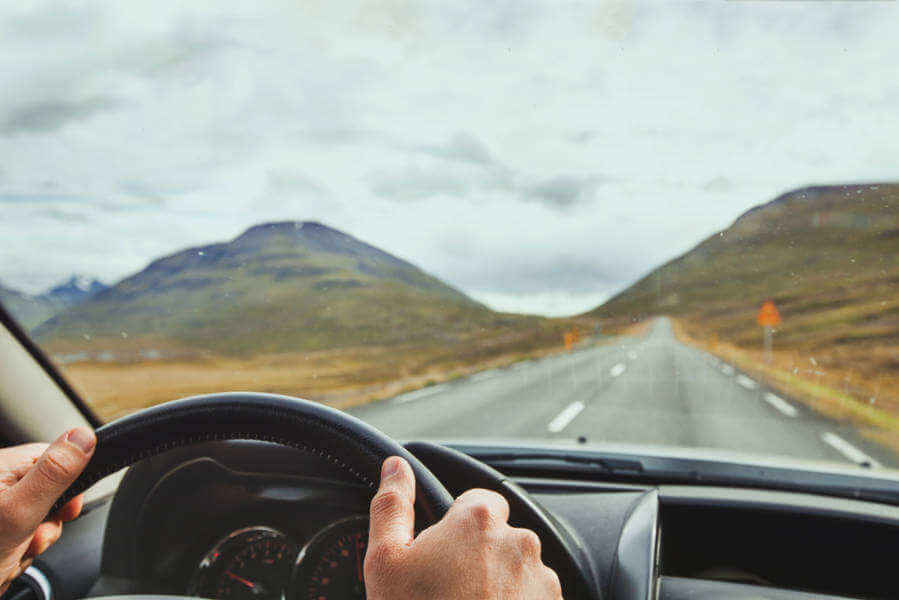Driving in Iceland in September just makes sense. The roads are open, the weather still plays along, and the scenery refuses to sit still. One stretch gives you black sand; the next bursts with steam and moss.
You drive, you stop, you take it in. That’s the pace. September doesn’t shove an itinerary at you. It lets you figure things out as you go. Not chaotic. Not boring. Just right.
Why September Is a Great Month for a Road Trip in Iceland
Visiting Iceland in September feels like you showed up right after the storm, but before winter slams the door shut. The prices? Way lower than in July. Car rentals in Iceland drop hard. We’re talking 10-20% off. Hotels and tours follow suit. So if you’re into stretching your budget without cutting corners, this is it.
The whole country slows down. Roads clear out. Small towns feel like towns again. And the light? Warm, low, and golden from morning to night. Autumn colors start creeping into lava fields and birch trees.
You’re still able to reach the good stuff, too. The Ring Road? Open. South Coast? No problem. You’re not stuck behind crowds or blocked by snowdrifts. An Iceland road trip in September gives you space, savings, and a version of the island that’s a little quieter, a little softer, and a lot easier to love.

Renting a Car in Iceland in September
Driving in Iceland in September sounds relaxed, but rentals can disappear faster than you think. Even though it’s off-peak, travelers flood in for autumn colors and early Northern Lights, so booking a few weeks ahead is the smart move.
At Reykjavik Cars, we have offices at both Keflavík International Airport and downtown Reykjavík. Airport pickup gets you going right away. City pickup can be cheaper, but you’ll need transport into town to start your self-drive trip. Most companies sneak in mileage caps or limit gravel coverage.
We don’t. Rent a car in Iceland with us, and you get uncapped mileage with the freedom to explore as far as you want. Just check the fuel type. Gasoline and diesel are both common, and full-tank returns are standard. Manual and automatic options are available, but automatics get snapped up fast. If that’s your preference, don’t wait.
What Type of Vehicle Should You Choose?
When it comes to self-driving in September in Iceland, the car you choose matters more than you think. It’s not just about price. It’s about where you’re going and how much gear you’ve packed. Here’s how to figure it out:
- Stick to paved roads? A 2WD will do the job on the Ring Road or the Golden Circle
- Want to save? 2WDs are cheaper but can’t legally drive on F-roads
- Heading into the Highlands? You’ll need a 4x4 by law for any F-road access
- Plan for river crossings or rough gravel? Only a 4x4 will handle it safely
- Traveling light? You’ll squeeze about 286 to 517 liters in the trunk of smaller cars, or around 10 to 18 cubic feet if you think in inches and gallons.
- Need more room? SUVs and 4x4s give you extra space and better ground clearance

Recommended Vehicles for Driving in Iceland in September
Not sure what to book? Don't know if you need a 4x4 to drive in Iceland in september or not? We’ve made it easy. Here’s what we recommend from our fleet, depending on your travel plans:
- For Paved Roads & Budget Travel - Hyundai i10, Toyota Aygo, Kia Rio. Perfect for the Ring Road and Golden Circle. Good if you're just two people and don’t need a trunk the size of a bathtub... Just keep it off the F-roads.
- For Comfort & Everyday Flexibility - Kia Ceed, Toyota Yaris, Skoda Octavia. More luggage space, a smooth ride, and ideal for longer drives or small families staying on paved roads.
- For F-Roads & Highland Access - Dacia Duster 4x4, Suzuki Vitara 4x4, Jeep Renegade. Built for rough terrain, river crossings, and legally allowed on F-roads. The right call for anyone heading into Iceland’s wild interior.

Insurance Options You Should Consider
Before you explore Iceland, do yourself a favor and don’t skip the extra insurance. Weather shifts fast, gravel flies, and ash storms are rare but vicious. Here’s what we offer at Reykjavik Cars:
- CDW (Collision Damage Waiver): Free with every rental. Covers third-party damage. It’s basic, but better than nothing.
- Premium Package: From 3300 ISK/day (27 USD). Includes Super Collision (SCDW), Gravel Protection (GP), Theft Protection (TP), and Sand and Ash (SAAP). Covers the stuff that actually happens here.
- Platinum Package: From 3951 ISK/day (32 USD). Includes everything in Premium, plus zero deductible. Full protection, no surprises.
September roads can be unpredictable. Wind. Gravel. One gust slams your door into a boulder, and suddenly that ‘savings’ move costs you triple. Get covered. It’s Iceland after all.

Booking Tips to Avoid Last-Minute Disappointment
You’d think September would be slow, but Iceland doesn’t work like that. Rental car demand stays high, and if you wait too long, you're either overpaying or driving whatever’s left. Here’s how to avoid that mess:
- Automatics go first. Most travelers don’t drive a manual, and neither do Iceland’s tourists. Book early if you want to avoid panic-picking from the leftovers.
- 4x4s disappear fast. People wake up one morning and decide they’re heading into the Highlands or chasing the Northern Lights. Boom. All the 4WDs vanish.
- Not dropping the car off where you picked it up? Then make sure your return location actually allows it.
- Watch for hidden fees. Gravel road restrictions, extra mileage, late returns, and added driver charges can sneak into the total if you’re not paying attention.
- Bonus tip: We offer a free extra driver on selected models like the Suzuki Jimny, Jeep Compass, Dacia Duster, and Toyota Yaris, for example. That’s real savings if you’re splitting the drive.

Weather and Road Conditions in September
You’d think by September things would calm down. Spoiler: it doesn’t. Here’s what you could expect from the weather and our roads:
What is the weather like in Iceland in September?
Weather conditions in September? You have no idea. Icelandic weather doesn’t explain itself. One second, it’s bright, warmish, kind of okay. The next second, you’re soaked, freezing, and yelling at your wipers.
South side like Reykjavík? Might hit 11°C (52°F) on a nice day. Nights? Down south, mornings hit about 6°C (43°F) if the wind doesn’t ruin it. The north? Maybe 8°C (46°F) during the day, then dips closer to 5°C (41°F). Doesn’t matter. You’ll still be cold.
Rain’s pretty normal. Reykjavík gets what, 87 mm (about 3 inches)? Or, something like that. The north is drier with around 53 mm (roughly 2 inches).
Wind? Don’t get us started. Feels harmless until it’s not. It’s there. Always. They say 15 to 21 km/h (9 to 13 mph), but it feels more like ‘get your hood up or regret it.’ Fog doesn’t exactly knock either. It just shows up. One blink and the whole road’s gone.

Is It Safe To Drive in Iceland in September?
Driving in Iceland during early autumn is surprisingly manageable if you know what to expect. September offers a great window where conditions are still friendly and most major routes remain open. A few things to know before you hit the road:
- The Ring Road and Golden Circle? Both are paved and in excellent shape. No snow or ice issues most of the time.
- September offers stable road conditions that make travel straightforward for most visitors
- Gravel shows up a lot once you leave town. So do potholes. Loose rocks don’t mess around either.
- Back off a bit on gravel. Flying stones love windshields, and cracked glass isn’t cheap.
- Temperatures drop more later in the month. Higher up or farther north? Even quicker.
- Watch for frost or black ice if you’re out late or before sunrise. They show up without warning. It’s nearly invisible. Look for patches of road that look wet but don’t spray water when other cars drive over them.

Road Closures and Highland Access
Iceland’s F-roads in September start to play hard to get. These rough, unpaved tracks lead deep into the island’s wild interior and are a dream for adventure seekers, until they’re not. Most F-roads begin closing in mid to late September.
By mid-October, almost all are shut down as snow, storms, and mud make them too risky to navigate. The best time to explore these routes is between July and early September. After that, it’s a gamble. Sudden closures can happen with little warning if the weather flips.
Only 4x4 vehicles are legally allowed on F-roads. Standard cars are not permitted. Some roads include river crossings, steep grades, and rocky sections that can destroy a small car in minutes. Even with a proper 4x4, if the route is marked “impassable,” it’s off-limits unless you’re in a super jeep with serious experience behind the wheel.
Your best move without off-road skills? Book a guided tour. It’s safer, less stressful, and still gets you deep into the highlands.

Must-See Routes and Destinations by Car
Not all drives are created equal. Some routes give you scenery that is way different in September. Less green, more gold, and wide open in every direction. These are the ones worth mapping out.
Best Scenic Drives in September
Some routes in Iceland are more than just a way to get from A to B. They’re the reason you came. September just happens to be one of the best times to drive them.
- Golden Circle goes big with minimal effort. It’s close to Reykjavík and easy to knock out in a day. You’ll hit Thingvellir, Gullfoss, and Strokkur without needing to plan much. No long drives, no detours, just the big stuff all in one loop.
- South Coast delivers Iceland’s greatest hits in one long stretch. This one runs east from Reykjavík and doesn’t hold back. Seljalandsfoss, Skógafoss, and black sand beaches near Vík. The kind of stops that end up on postcards. Give yourself a full day. Perhaps even maybe more.
- Snæfellsnes Peninsula is wild, coastal, and seriously underrated. You get a bit of everything. Craters, cliffs, beaches, and a glacier on top just to flex. Not as busy as the South Coast, but just as loaded with scenery. And the loop keeps it simple.

Can You Drive the Highlands in September?
Thinking about hitting the Highlands while traveling to Iceland in September? Just know what you’re signing up for. It’s doable, but definitely not beginner-friendly.
F-roads like F35 or F26 might still be open early in the month. No guarantees, though, so check before you go. After mid-September, closures pick up fast. Rain, snow, or sudden storms can shut a road down without much warning. Once it’s closed, that’s it.
You’ll need a proper 4x4. Not just something that looks tough. Some areas turn rough quickly. You should be well prepared in advance for loose gravel, uneven surfaces, and rivers. The river crossings can be anything from 20 to 60 cm deep (8 to 24 inches). If the current gets strong or rain hits hard, those crossings can turn risky freaking fast. Be cautious. If the route looks sketchy, don’t push it.
Rental companies often block access later in the month. They’ve seen too many soaked engines and emergency rescues to take chances. Not sure about river crossings or rocky trails? Don’t wing it. Go with a guide instead.
Driving the Ring Road and Westfjords
If you're grabbing a rental car in Iceland and eyeing the full loop, the Ring Road practically rolls out a red carpet. It’s paved, marked, and built for travelers who don’t feel like decoding road signs in the middle of nowhere. Most folks take 7 to 10 days to circle it, and in September, you’re not elbowing your way through traffic or skidding on early snow. Sounds like a win.
Fuel stops pop up almost every 50 kilometers (30 miles), which means you won’t be stranded unless you really try. Still, top up before heading into the more remote bits. No one wants to coast into the Westfjords on fumes.
That said, the Westfjords don’t play nice. Gravel roads, sharp climbs, and moody weather are part of the deal. It’s tougher going but wildly scenic. Just don’t expect drive-throughs or radio signal. Welcome to Iceland’s version of a digital detox.

Essential Driving Tips for September Visitors
September might give you 12 hours of daylight, but don’t let that fool you. Iceland’s weather doesn’t care what your plan is. Blue skies in the morning? Cool. By lunch you could be pulling over in fog so thick you can’t see past the hood.
If you want real driving tips for Iceland in September, here’s one: check the damn weather before you leave. Especially if you’re heading anywhere off the Ring Road. Fuel up often. Hold your door tight. And don’t assume the weather owes you anything. Here is some more really great tips on how to drive responsibly in Iceland.
Checking Weather and Road Alerts
Let’s be clear. If you’re not checking conditions at least three times a day, you’re not ready to drive in Iceland.
- Mornings might look fine, but check again before you leave and again at lunch. Forecasts here flip faster than your travel playlist.
- Vedur.is and its app are what locals trust. Use them or risk driving blind.
- Umferdin.is gives you the real scoop on road closures, webcam footage, and what’s open.
- Safetravel.is throws in travel alerts and emergency info. Keep it bookmarked.
- Storms can show up out of nowhere. So can closed roads.
- If you see a barrier, don’t play hero. Pull over, get comfortable, and wait it out.
- Mountain passes? Remote stretches? They don’t care how ‘nice’ the morning looked.
- Follow the Icelanders. They’re not checking conditions out of boredom.

Legal Requirements for Driving in Iceland
Before you hit the road, make sure you know everything you need to stay on the right side of the law:
- You’ll need a valid driver’s license from your home country. Licenses from the US, UK, EU/EEA, Canada, Australia, China, India, and Malaysia are all accepted.
- The legal driving age is 17, but renting a car is a different story:
- 20 and up for standard vehicles
- 23 to 25 for 4x4s, SUVs, or campervans, depending on the rental company
- Your license must be at least one year old.
- Seatbelts are non-negotiable. Every seat, every time.
- Headlights must be on at all hours, no matter how bright the sky looks.
- Using a phone? Only with hands-free. No exceptions.
- Iceland takes drink driving seriously. Zero tolerance. Expect steep fines or jail if you mess around.
- Speed limits are:
- 50 km/h (31 mph) in towns
- 80 km/h (50 mph) on gravel roads
- 90 km/h (56 mph) on paved rural roads
- Speed cameras are common and the fines are brutal. Don’t test it.

Fuel Stations, Parking, and Local Etiquette
If you're driving in Iceland in September, don't expect every road trip stop to come with snacks and a toilet. Here's the lowdown:
- Reykjavík has plenty of fuel stations. Beyond city limits? Not so much. Fill up when you can, or prepare to sweat through 100 km (62 miles) of fuel gauge anxiety.
- Most stations are self-service, 24/7, and picky. You’ll need a chip-and-PIN card. Swipe-and-hope won't cut it.
- No PIN? Grab a prepaid fuel card unless you enjoy hitchhiking.
- Gas prices in Iceland sit around 320 ISK per liter (about 9.50 USD per gallon). So yes, road-tripping here costs more than your flight.
- Parking in Reykjavík runs on a zone system. Four colors, four levels of ‘please pay attention.’ Use meters or the Parka app unless you like surprise fines.
- Do not block roads to photograph sheep. Pull over at marked spots like a decent human.
What to Pack for a September Road Trip
Here’s what earns a spot in your bag when coming to our island in September:
- Clothes you can stack. Think thermal base layers, fleece, and a decent waterproof jacket. Trust me, you’ll be peeling or adding layers all day.
- Something to block the wind. A hat that doesn’t fly off and a jacket that doesn’t flap like a parachute.
- Boots made for puddles. Or rivers. Or mud. Just don’t show up in sneakers.
- A mini survival stash. Toss in a phone charger, a warm blanket, and snacks. Road closures don’t care if you're hungry or out of signal.
- Sunglasses. No, really. The sun angles low and reflects off everything like a passive-aggressive flashlight.
- Water bottle. Tap water’s elite here. Don’t waste your money on the bottled kind.
- Swimsuit. Hot springs don’t close for weather. You’ll regret not packing it.

Is Driving in Iceland in September Worth It?
Driving in Iceland in September isn’t just doable, it’s the sweet spot. No tourist chaos, just open roads, cool air, and that eerie silence only Iceland pulls off. You’re not just seeing the country, you’re feeling it as it slips into autumn.
The weather can be moody. So what? It keeps things real. If you’ve ever wanted Iceland to feel like it’s yours, this is the time to go. Don’t wait for perfect. It never shows up anyway.


 By
By


